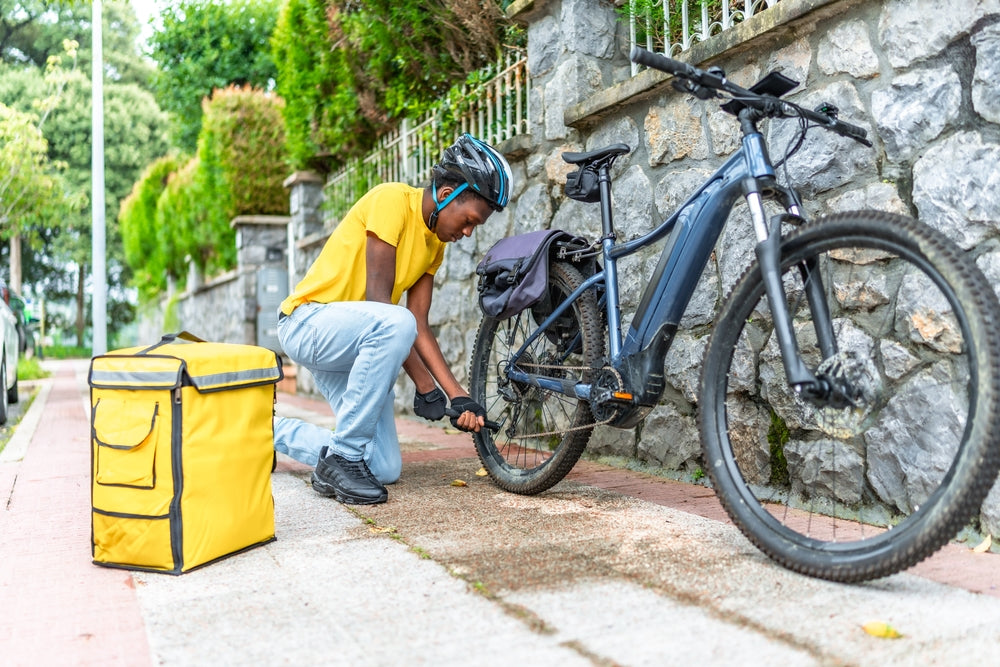You're thinking about buying an electric bike. Or maybe you already own one. Either way, you've got one big question: how far can it actually go?
The answer isn't simple. But it's not complicated either.
Most e-bikes travel between 20 and 50 miles on a single charge. Some go further. Some don't make it that far. It depends on a bunch of factors—some you can control, some you can't.
Let's break it down.
What Is E-bike Range?
Range is the distance your e-bike can travel before the battery dies.
Simple enough.
But here's the thing. The number you see in the product description? That's usually the best-case scenario. Flat roads. No wind. Light rider. Low assist mode.
Real life doesn't work that way.
What Affects Your E-bike's Range?
Battery Size
Bigger battery = longer range.
Battery capacity is measured in watt-hours (Wh). A 500Wh battery holds more power than a 400Wh battery. More power means more miles.
Most e-bikes come with batteries between 400Wh and 750Wh. Some high-end models pack over 1,000Wh.
Weight
The heavier you are, the harder your motor works.
More weight means more energy. That includes your body weight, cargo, and the bike itself.
A 200-pound rider will drain the battery faster than a 150-pound rider. Add groceries or a backpack, and range drops even more.
Terrain
Hills kill your battery.
Going uphill requires way more power than riding on flat ground. Your motor fights both friction and gravity.
Rough terrain also drains power faster. Gravel, dirt, and sand create more resistance than smooth pavement.
Speed
The faster you go, the quicker your battery dies.
High speeds demand more power from the motor. If you're constantly riding at top speed, expect shorter range.
Moderate speeds give you the best balance between speed and battery life.
Assist Level
Most e-bikes have multiple assist levels—usually 3 to 5 settings.
Higher assist = more motor power = less range.
Lower assist levels use less battery but require more pedaling effort from you.
Weather
Cold weather reduces battery performance.
Batteries work best between 50°F and 77°F. When it's cold, chemical reactions inside the battery slow down. You'll notice shorter range in winter.
Wind also matters. Headwinds force your motor to work harder. Tailwinds help extend range.
Tire Pressure
Low tire pressure creates more rolling resistance.
Check your tire pressure regularly. Properly inflated tires roll easier and use less battery power.
Stop-and-Go Riding
Starting from a complete stop uses more energy than maintaining speed.
Frequent stops drain your battery faster. City riding with lots of traffic lights will give you less range than a steady ride on open roads.
How Different E-bikes Compare
| E-bike Type | Typical Range | Battery Size | Best For |
|---|---|---|---|
| City/Commuter | 30-50 miles | 400-500Wh | Daily commutes, errands |
| Mountain | 20-40 miles | 500-750Wh | Off-road trails, steep climbs |
| Cargo | 20-35 miles | 500-900Wh | Hauling kids, groceries |
| Folding | 15-30 miles | 250-350Wh | Mixed commutes, storage |
| Road | 40-80 miles | 300-500Wh | Long-distance rides |
How to Maximize Your E-bike Range
Use Lower Assist Levels
You don't always need maximum power.
Save the high assist levels for hills and headwinds. Use lower settings on flat ground. You'll pedal a bit more, but your battery will last longer.
Pedal More
The more you pedal, the less your motor works.
Pedal assist is more efficient than throttle-only riding. Even light pedaling helps extend range.
Keep Your Cadence Steady
Aim for 70-75 pedal revolutions per minute. This cadence is efficient for both your body and the motor.
Avoid mashing the pedals in high gears. Shift to easier gears and spin faster.
Maintain Your Bike
A well-maintained bike uses less energy.
- Keep your chain clean and lubed
- Check tire pressure before rides
- Make sure brakes aren't rubbing
- Keep moving parts clean
Regular maintenance can improve efficiency by 10-15%.
Plan Your Route
Choose flatter routes when possible.
A longer flat route might actually use less battery than a shorter hilly one. Use bike route apps to find the most efficient paths.
Reduce Weight
Carry only what you need.
Every extra pound requires more energy. Leave unnecessary items at home.
Ride Smoothly
Avoid sudden acceleration and hard braking.
Smooth, steady riding is more efficient than constantly speeding up and slowing down.
Store Your Battery Properly
Temperature matters even when you're not riding.
- Store batteries at room temperature
- Keep charge between 20% and 80% for long-term storage
- Don't leave batteries in hot cars or freezing garages
- Charge at room temperature, not in extreme cold or heat
Consider a Second Battery
Some e-bikes let you add a second battery.
This doubles your range. It's the simplest solution if you regularly take long rides.
Battery Life vs. Battery Range
These are different things.
Battery range = how far you can ride on one charge
Battery life = how long the battery lasts before it needs replacement
Most e-bike batteries last 500 to 1,000 charge cycles. That's typically 2-5 years depending on use.
Over time, batteries lose capacity. A battery that gave you 50 miles when new might only give you 40 miles after a few years.
Signs Your Battery Is Wearing Out
- Range is noticeably shorter than when new
- Battery takes longer to charge
- Battery doesn't hold a charge
- Physical damage or swelling
When this happens, it's time for a replacement battery.
What to Expect in Real-World Riding
Manufacturer estimates are optimistic.
If a bike claims 60 miles of range, expect 40-50 miles in normal conditions. Maybe 30-40 miles if you're riding in hilly terrain with high assist.
That's not a bad thing. Just plan accordingly.
Getting the Most from Your E-bike
Range anxiety is real. But it's manageable.
Know your bike's capabilities. Understand what drains the battery. Adjust your riding style. Keep your bike maintained.
Do these things and you'll get more miles per charge. You'll also extend the overall life of your battery.
And that means more time riding, less time worrying about running out of power.





